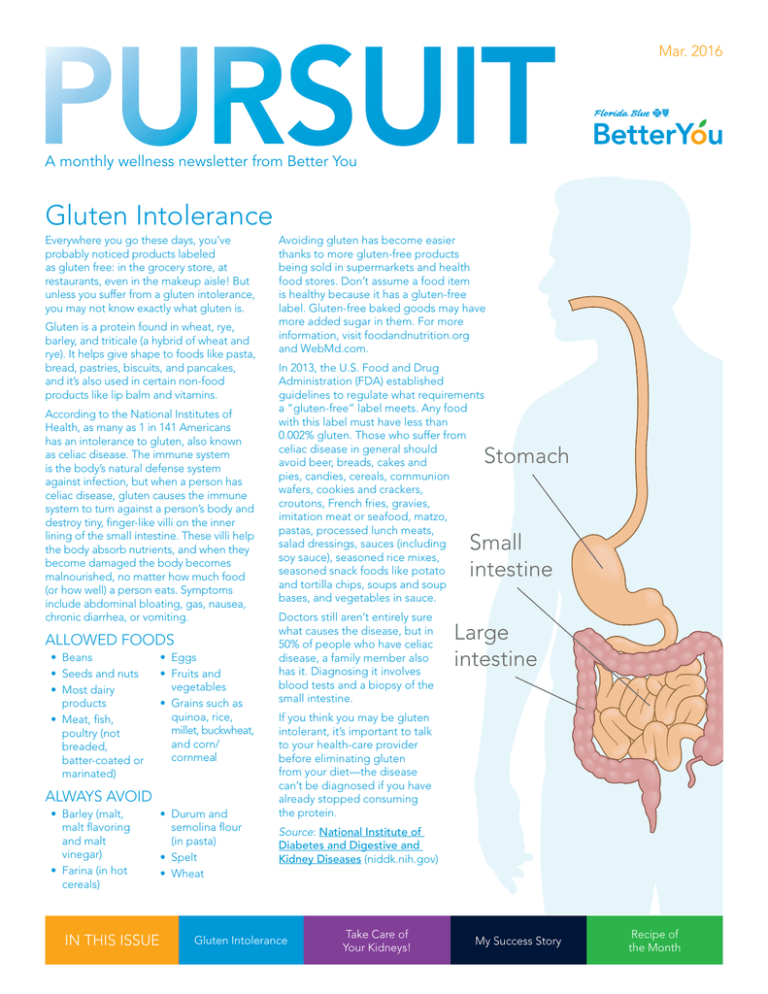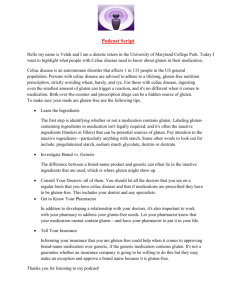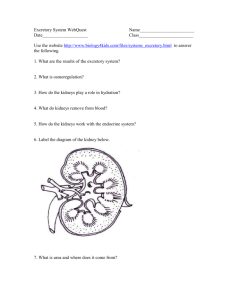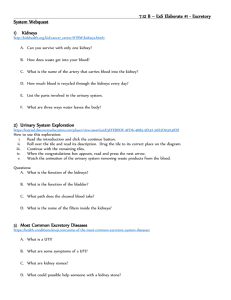PURSUIT Gluten Intolerance A monthly wellness newsletter from Better You Mar. 2016
advertisement

PURSUIT Mar. 2016 A monthly wellness newsletter from Better You Gluten Intolerance Everywhere you go these days, you’ve probably noticed products labeled as gluten free: in the grocery store, at restaurants, even in the makeup aisle! But unless you suffer from a gluten intolerance, you may not know exactly what gluten is. Gluten is a protein found in wheat, rye, barley, and triticale (a hybrid of wheat and rye). It helps give shape to foods like pasta, bread, pastries, biscuits, and pancakes, and it’s also used in certain non-food products like lip balm and vitamins. According to the National Institutes of Health, as many as 1 in 141 Americans has an intolerance to gluten, also known as celiac disease. The immune system is the body’s natural defense system against infection, but when a person has celiac disease, gluten causes the immune system to turn against a person’s body and destroy tiny, finger-like villi on the inner lining of the small intestine. These villi help the body absorb nutrients, and when they become damaged the body becomes malnourished, no matter how much food (or how well) a person eats. Symptoms include abdominal bloating, gas, nausea, chronic diarrhea, or vomiting. ALLOWED FOODS • Beans • Seeds and nuts • Most dairy products • Meat, fish, poultry (not breaded, batter-coated or marinated) • Eggs • Fruits and vegetables • Grains such as quinoa, rice, millet, buckwheat, and corn/ cornmeal ALWAYS AVOID • Barley (malt, malt flavoring and malt vinegar) • Farina (in hot cereals) IN THIS ISSUE • Durum and semolina flour (in pasta) • Spelt • Wheat Avoiding gluten has become easier thanks to more gluten-free products being sold in supermarkets and health food stores. Don’t assume a food item is healthy because it has a gluten-free label. Gluten-free baked goods may have more added sugar in them. For more information, visit foodandnutrition.org and WebMd.com. In 2013, the U.S. Food and Drug Administration (FDA) established guidelines to regulate what requirements a “gluten-free” label meets. Any food with this label must have less than 0.002% gluten. Those who suffer from celiac disease in general should avoid beer, breads, cakes and pies, candies, cereals, communion wafers, cookies and crackers, croutons, French fries, gravies, imitation meat or seafood, matzo, pastas, processed lunch meats, salad dressings, sauces (including soy sauce), seasoned rice mixes, seasoned snack foods like potato and tortilla chips, soups and soup bases, and vegetables in sauce. Stomach Small intestine Doctors still aren’t entirely sure what causes the disease, but in 50% of people who have celiac disease, a family member also has it. Diagnosing it involves blood tests and a biopsy of the small intestine. Large intestine If you think you may be gluten intolerant, it’s important to talk to your health-care provider before eliminating gluten from your diet—the disease can’t be diagnosed if you have already stopped consuming the protein. Source: National Institute of Diabetes and Digestive and Kidney Diseases (niddk.nih.gov) Gluten Intolerance Take Care of Your Kidneys! My Success Story Recipe of the Month Take Care of Your Kidneys! The kidneys are two bean-shaped organs, about the size of your fist, located in the middle of your back, one on either side of the spine. They are powerhouses that filter out waste and make urine. The kidneys produce hormones to keep blood levels of salt and minerals balanced and control blood pressure. Early kidney disease has no signs or symptoms. Its main causes are: • Not drinking enough water • Immune system conditions • Damage to the kidney during a severe blood infection • Harm from drugs and toxins, such as chronic use of ibuprofen, naproxen, or street drugs • Birth defects • Bladder infections Chronic kidney disease happens slowly over many years. When your kidneys become damaged, they stop working properly and cause waste and fluid to build up in the body, leading to symptoms like ankle swelling, vomiting, weakness, poor sleep and shortness of breath. Both type I and type II diabetics and hypertensive adults have a higher risk of developing chronic kidney disease (CKD). Approximately 1 in 3 adults with diabetes and 1 in 5 adults with high blood pressure has CKD. Other risk factors for CKD include heart and blood vessel disease, obesity, lupus, high cholesterol and family history of kidney failure. Alarmingly, the Centers for Disease Control and Prevention estimate that as of 2015 more than 20 million Americans aged 20 years and older have kidney disease—this is 10% of the U.S. population! In fact, every day more than 300 people begin treatment for kidney failure. Use the following checklist to make sure you keep your kidneys healthy and happy! ❏ Know your risks for kidney disease ❏ Get regular blood and urine testing ❏ Manage diabetes by watching blood sugars ❏ Control high blood pressure and keep blood pressure below 150/90 ❏ Avoid drugs and toxins ❏ Drink lots of water The good news is that the earlier you know you have kidney disease, the better your chances of avoiding kidney failure, which requires dialysis or a kidney transplant. My Success Story by Emily J. "Leigh" Edwards (Left: Tiller, Right: Emily) At the annual health assessment, most know me as “the lady with the papers.” Since 2011, I have kept the results from my assessments, and I bring them with me so I can look at the year over year comparisons. Every single year, almost all my numbers improve. It took five years, several doctors and several medication changes to make this happen, but my true motivator was Bridget Jennings, whom I met in 2010. I made an appointment to see her in the onsite clinic because I was looking for advice on managing my type 2 diabetes, which I was having real trouble controlling. Bridget coached me following the screening event in 2010. My blood sugar was in the 200–300 range every day. I was telling her about my personal history when I just burst into tears. I felt so helpless and unhappy—the high blood sugar was slowly cooking my brain, leaving me unable to understand what was happening. Bridget was so kind and such a great listener. After she got me tissues, she gently said that I was slurring my words and she could see I was at the end of my rope. She started working with me that day, and she helped me so much—patiently teaching me the importance of exercise, keeping a food journal, portion control, balancing my diet and everything else connected with gaining control of my own life. Every year at the health screening event, I am delighted that I’m improving my cholesterol values and blood sugar from the previous year, and I share my improvements with every volunteer who doesn’t run away first! At the top of that list is health coach Susan Tiller, who’s been there for me year after year coaching me after I receive my results. She’s been a rock of support, and it means so much that she listens intently, asks good questions, and gives unwavering, sensible advice. Thanks to her, I now have a game plan for the next 12 months. I’m glad to be known as the lady with the papers, and you can count on me to show up next year. I’m going to impress you again, Tiller! MAR 2016 2 Fresh and Healthy Recipe of the Month Quinoa Salad Quinoa originated in South America and is rich in B vitamins, minerals, antioxidants and hearthealthy mono-unsaturated fat. It is a good gluten-free side dish alternative. Serves 4 Ingredients: • 1 cup quinoa PHOTO COURTESY: MAYOCLINIC.COM • 1 1/4 cups water • 1 lemon, juiced (about 2 tablespoons) • 1 garlic clove, minced • 1/4 teaspoon ground black pepper • 2 tablespoons olive or canola oil • 1 large cucumber, seeded and cut into 1/2-inch pieces • 1 pint cherry tomatoes, halved • 1/3 cup chopped parsley • 1/4 cup chopped red onion • 1/2 cup reduced-fat feta cheese Directions: 1. In a medium saucepan over high heat, bring quinoa and water to a boil. Reduce heat to medium-low and cover. Simmer for about 10 minutes or until the quinoa is tender. 2. Remove quinoa from heat and let stand, covered, for 5 minutes. Then fluff quinoa with a fork and spread it out onto a large rimmed baking sheet to cool. 3. In a small bowl, whisk lemon juice, garlic and pepper. Gradually whisk in oil. 4. After the quinoa has cooled, transfer it to a large bowl and add the dressing, cucumber, tomatoes, parsley and onion. Top with feta cheese and toss gently to mix. Nutrition: Serving size: about 2 cups. Calories 313; Total fat 13 g; Saturated fat 3 g; Trans fat 0 g; Monounsaturated fat 5 g; Cholesterol 10 mg; Sodium 177 mg; Total carbohydrate 40 g; Dietary fiber 6 g; Sugars 0 g; Protein 9 g. Recipe courtesy of MayoClinic.com Florida Blue is a trade name of Blue Cross and Blue Shield of Florida, Inc., an Independent Licensee of the Blue Cross and Blue Shield Association. All materials, content and forms contained in this newsletter are the intellectual property of Better You and may not be copied, reproduced, distributed or displayed in full or in part without expressed written permission by Better You. 86044 0316 MAR 2016 3






